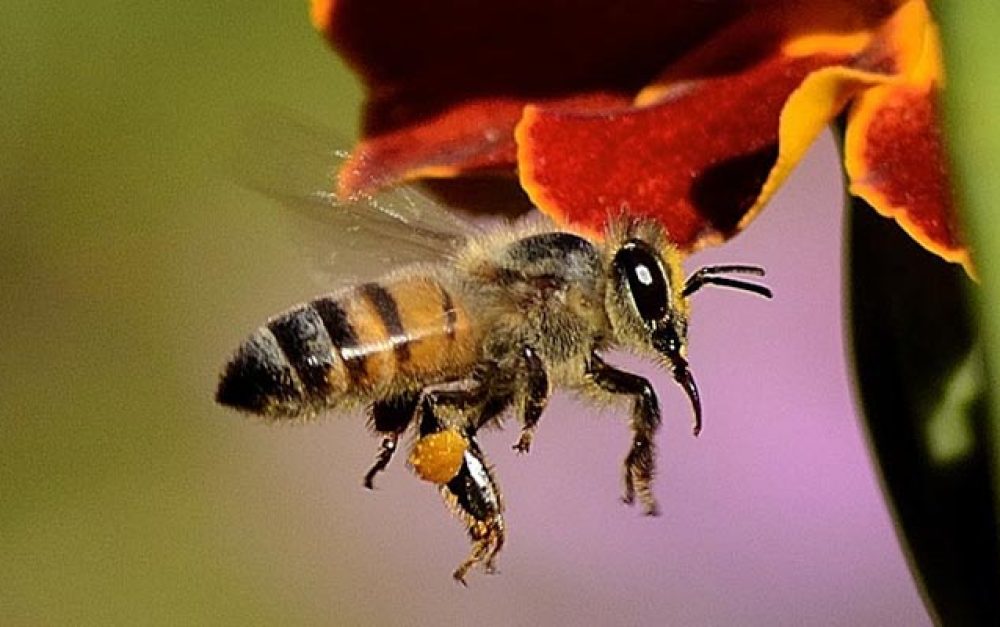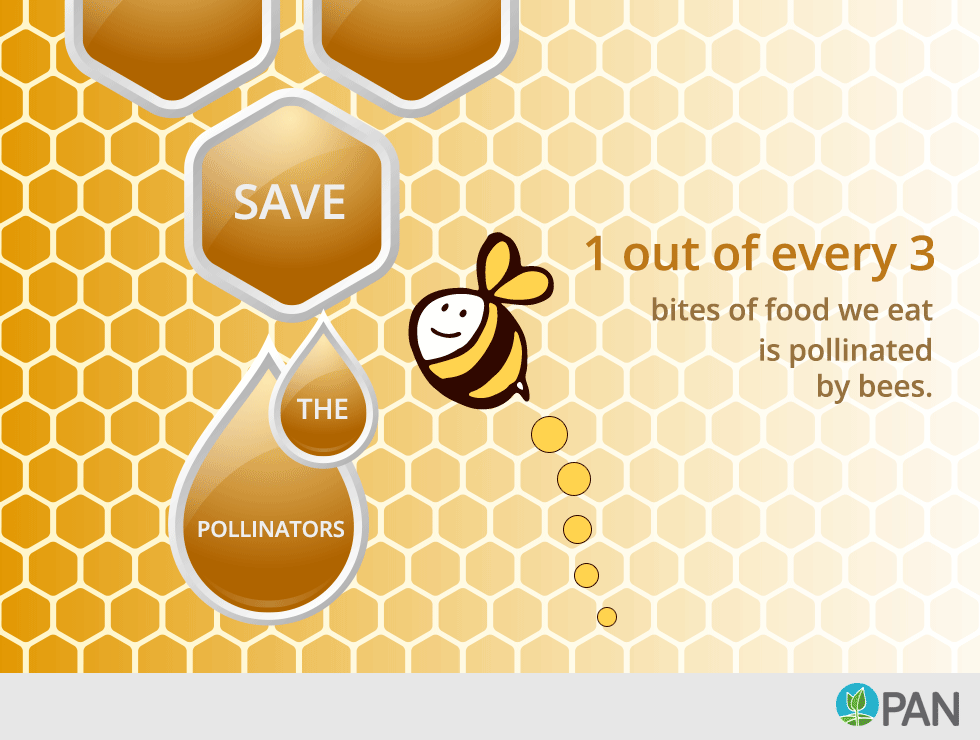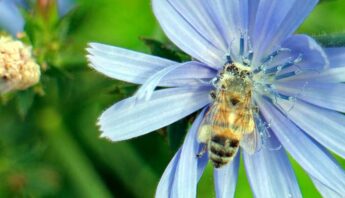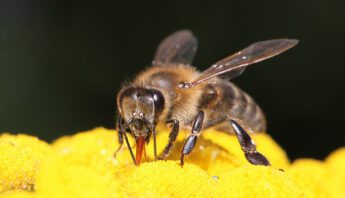Bees pollinate a significant majority of the world’s food — and these vital pollinators are in serious trouble.
In North America alone, honey bees pollinate nearly 95 kinds of fruits and nuts, including almonds, avocados, cranberries and apples. Each of us relies on bees — and the pollination services they provide — every day. But bees and other pollinators are reaching a tipping point, with beekeepers reporting annual hive losses of a third or more in recent years.
What’s at the root of this alarming trend? Scientists agree there are multiple, interacting causes at play, including pathogens, nutrition and habitat loss — and pesticide exposure is a key factor, exacerbating other stressors.
Federal policymakers are moving too slowly to implement pollinator protective policies, but bees need meaningful action — and they need it now.
What we’re doing
Working with beekeepers, farmers and scientists, PAN is building momentum for pollinator-protective policies across the country. Together with our partners, we’re keeping the pressure on decisionmakers in D.C. and state capitals from Minnesota to California to take bee-harming pesticides off the market.
The Environmental Protection Agency (EPA) allowed neonicotinoids onto the market without sufficient review — and the agency has been incredibly slow to wrap up its review, even though independent science shows a clear connection between these commonly used insecticides and bee declines. It’s time for action!
EPA also allows the widespread use of neonicotinoids as a seed coating on crops like corn and soy, even though this practice doesn’t much help farmers. In fact, seed treatments are so common that farmers report it’s nearly impossible to purchase commodity crop seed that isn’t covered in neonics. And, because EPA doesn’t count seed treatments as a “pesticide application” and therefore doesn’t track or regulate them as such, bees continue being exposed on farmland across the country.
We’re also urging the U.S. Department of Agriculture to increase pesticide-free pollinator habitat and expand support for agroecological, pollinator-friendly farming practices.
Get involved!
Want to take action for bees? Here are a few ways to get involved in this important campaign.
- Sign up! Join our alert list to receive the latest news and actions for bees.
- Keep the issue front & center. Write a letter to the editor of your local papers or submit an OpEd. Decisionmakers pay attention to media coverage!
- Build momentum. Talk to your friends, family, neighbors about the importance of bees and other pollinators — and the challenges they’re facing. And ask them to join this campaign too!
- Create a Honey Bee Haven. Have a yard or plants on your front step? Grow bee-friendly plants and keep the space pesticide free. Urge your town or city to pass a resolution and become a bee haven too!
For more tips and tools for bees, download our “Bee the Change” toolkit. And share with your community!
Dig deeper
Want to learn more? Click below for additional details about the challenges facing bees and what to do about it.
Pesticides & pollinators
The causes behind recent bee declines are not a “mystery.” After having tried and failed to link them with a particular parasite, virus, fungus or other pathogen, scientists now largely concur that bee declines are caused by a combination of increased overall pathogen loads, poor nutrition and pesticide exposure. Recent debates have hinged on which of these three co-factors is driving losses most directly.
In the last few years, neonicotinoid pesticides — both alone and in combination with other pesticides — have emerged as the leading suspects because of their direct toxicity to bees and because of their indirect and cascading effects.
For example, individual bees can be acutely poisoned while flying through pesticide-contaminated planter dust in a recently planted corn field; or chronically poisoned at sub-lethal levels by eating and drinking contaminated pollen, nectar and/or water over time. (Neonics are water soluble and persist for months in the environment.) Bees are then more likely to get sick, less able to forage effectively, and so on.
Colonies experience these poisonings at the population level as a hive’s highly interdependent generational cycles, immune system functions and social communication abilities are disrupted.
The weight of evidence from independent, peer-reviewed studies clearly indicates that neonicotinoids — this relatively new, long-lasting and widely used class of pesticides— are a key driver behind continuing bee declines.
Still, industry studies provide much of the basis for regulatory decisionmaking in the U.S. One consequence of this arrangement is that products such as neonics are rushed to market and remain there before rigorous toxicity tests have been conducted.
U.S. behind the curve
While federal regulators in the U.S. remain paralyzed — apparently captive to industry-funded science and a regulatory framework that finds chemicals innocent until proven guilty — European governments are heeding the science and taking action.
In 2013, the European Food Safety Authority released a report concluding that neonics pose an “unacceptable risk” to bees. This report prompted a two-year ban of neonics in the European Union, which was implemented in December 2013 and is being extended.
Additionally, Canada moved towards banning the neonic pesticide imidacloprid after Health Canada’s Pesticides Management Regulatory Agency concluded that the pesticide is highly toxic to pollinators in late 2016. Health Canada will conduct special reviews over the next two years, and has proposed to ban imidacloprid for major agricultural uses in the next three to five years.
The U.S. Environmental Protection Agency is still conducting a review of neonicotinoids — slated to complete in 2018 — and the White House issued a memo in 2014 pressing the federal agencies to directly address pollinator declines. And while some steps toward improved habitat have been made, the pesticide problem remains largely unaddressed.
Community “Bee Havens”
Across the country, people are stepping up to protect bees in their backyards and communities by creating pesticide-free “honey bee havens” with ample pollinator habitat and access to fresh water.
Don’t have a yard? A few containers of the right kinds of plants on a balcony or front stoop will get you started with your pollinator safe haven.
Communities that have already passed resolutions declaring themselves havens — committing to stop the use of neonicotinoid pesticides and increase pollinator habitat — include:
- Andover, Minnesota
- El Cerrito, California
- Minneapolis, Minnesota
- Portland, Oregon
- Sacramento, California
- Seattle, Washington
- Shorewood, Minnesota
- Spokane, Washington
And many more are in the works! Want to create a bee haven in your garden or community? Visit www.honeybeehaven.org to learn more and put your haven on the map.








